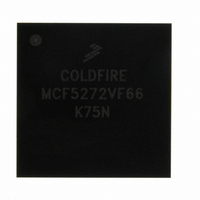MCF5272VF66 Freescale Semiconductor, MCF5272VF66 Datasheet - Page 135

MCF5272VF66
Manufacturer Part Number
MCF5272VF66
Description
IC MPU 32BIT 66MHZ 196-MAPBGA
Manufacturer
Freescale Semiconductor
Series
MCF527xr
Specifications of MCF5272VF66
Core Processor
Coldfire V2
Core Size
32-Bit
Speed
66MHz
Connectivity
EBI/EMI, Ethernet, I²C, SPI, UART/USART, USB
Peripherals
DMA, WDT
Number Of I /o
32
Program Memory Size
16KB (4K x 32)
Program Memory Type
ROM
Ram Size
1K x 32
Voltage - Supply (vcc/vdd)
3 V ~ 3.6 V
Oscillator Type
External
Operating Temperature
0°C ~ 70°C
Package / Case
196-MAPBGA
Lead Free Status / RoHS Status
Contains lead / RoHS non-compliant
Eeprom Size
-
Data Converters
-
Available stocks
Company
Part Number
Manufacturer
Quantity
Price
Company:
Part Number:
MCF5272VF66
Manufacturer:
HYNIX
Quantity:
19
Company:
Part Number:
MCF5272VF66
Manufacturer:
FREESCAL
Quantity:
885
Company:
Part Number:
MCF5272VF66
Manufacturer:
Freescale Semiconductor
Quantity:
10 000
Part Number:
MCF5272VF66
Manufacturer:
FREESCALE
Quantity:
20 000
Company:
Part Number:
MCF5272VF66J
Manufacturer:
Freescale
Quantity:
256
Company:
Part Number:
MCF5272VF66J
Manufacturer:
Freescale Semiconductor
Quantity:
10 000
Company:
Part Number:
MCF5272VF66R2
Manufacturer:
Freescale Semiconductor
Quantity:
10 000
Company:
Part Number:
MCF5272VF66R2J
Manufacturer:
Freescale Semiconductor
Quantity:
10 000
- Current page: 135 of 544
- Download datasheet (7Mb)
5.5.2
When the CPU is halted and PST reflects the halt status, the development system can send unrestricted
commands to the debug module. The debug module implements a synchronous protocol using two inputs
(DSCLK and DSI) and one output (DSO), where DSO is specified as a delay relative to the rising edge of
the processor clock. See
master and must generate DSCLK.
The serial channel operates at a frequency from DC to 1/5 of the PSTCLK frequency. The channel uses
full-duplex mode, where data is sent and received simultaneously by both master and slave devices. The
transmission consists of 17-bit packets composed of a status/control bit and a 16-bit data word. As shown
in
high; that is, DSI is sampled and DSO is driven.
DSCLK and DSI are synchronized inputs. DSCLK acts as a pseudo clock enable and is sampled on the
rising edge of the processor CLK as well as the DSI. DSO is delayed from the DSCLK-enabled CLK rising
edge (registered after a BDM state machine state change). All events in the debug module’s serial state
machine are based on the processor clock rising edge. DSCLK must also be sampled low (on a positive
edge of CLK) between each bit exchange. The MSB is transferred first. Because DSO changes state based
on an internally-recognized rising edge of DSCLK, DSDO cannot be used to indicate the start of a serial
transfer. The development system must count clock cycles in a given transfer. C1–C4 are described as
follows:
Freescale Semiconductor
Figure
•
•
•
•
C1—First synchronization cycle for DSI (DSCLK is high).
C2—Second synchronization cycle for DSI (DSCLK is high).
C3—BDM state machine changes state depending upon DSI and whether the entire input data
transfer has been transmitted.
C4—DSO changes to next value.
5-12, all state transitions are enabled on a rising edge of the PSTCLK clock when DSCLK is
BDM State
PSTCLK
Machine
BDM Serial Interface
DSCLK
DSO
A not-ready response can be ignored except during a memory-referencing
cycle. Otherwise, the debug module can accept a new serial transfer after 32
processor clock periods.
DSI
MCF5272 ColdFire
Table
5-1. The development system serves as the serial communication channel
Current State
Figure 5-12. BDM Serial Interface Timing
Past
®
Integrated Microprocessor User’s Manual, Rev. 3
C1
Current
C2
NOTE
C3
C4
Next State
Current
Next
Debug Support
5-17
Related parts for MCF5272VF66
Image
Part Number
Description
Manufacturer
Datasheet
Request
R
Part Number:
Description:
Mcf5272 Coldfire Integrated Microprocessor User
Manufacturer:
Freescale Semiconductor, Inc
Datasheet:

Part Number:
Description:
MCF5272 Interrupt Service Routine for the Physical Layer Interface Controller
Manufacturer:
Freescale Semiconductor / Motorola
Datasheet:
Part Number:
Description:
Manufacturer:
Freescale Semiconductor, Inc
Datasheet:
Part Number:
Description:
Manufacturer:
Freescale Semiconductor, Inc
Datasheet:
Part Number:
Description:
Manufacturer:
Freescale Semiconductor, Inc
Datasheet:
Part Number:
Description:
Manufacturer:
Freescale Semiconductor, Inc
Datasheet:
Part Number:
Description:
Manufacturer:
Freescale Semiconductor, Inc
Datasheet:
Part Number:
Description:
Manufacturer:
Freescale Semiconductor, Inc
Datasheet:
Part Number:
Description:
Manufacturer:
Freescale Semiconductor, Inc
Datasheet:
Part Number:
Description:
Manufacturer:
Freescale Semiconductor, Inc
Datasheet:
Part Number:
Description:
Manufacturer:
Freescale Semiconductor, Inc
Datasheet:
Part Number:
Description:
Manufacturer:
Freescale Semiconductor, Inc
Datasheet:
Part Number:
Description:
Manufacturer:
Freescale Semiconductor, Inc
Datasheet:
Part Number:
Description:
Manufacturer:
Freescale Semiconductor, Inc
Datasheet:
Part Number:
Description:
Manufacturer:
Freescale Semiconductor, Inc
Datasheet:











